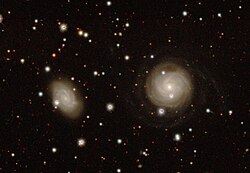Astronomy:NGC 2617
| NGC 2617 | |
|---|---|
 legacy surveys image of NGC 2617 (right) and MCG-01-22-027 | |
| Observation data (J2000 epoch) | |
| Constellation | Hydra |
| Right ascension | 08h 35m 38.798s[1] |
| Declination | −04° 05′ 17.90″[1] |
| Helio radial velocity | 4,287 km/s[2] |
| Distance | 201.8 Mly (61.86 Mpc)h−10.73[2] |
| Apparent magnitude (V) | 12.66±0.20[3] |
| Apparent magnitude (B) | 14.10±0.30[3] |
| Characteristics | |
| Type | Sc[4][3] |
| Apparent size (V) | 0.693′ × 0.652′[5] (infrared) |
| Other designations | |
| IRAS F08331-0354, NGC 2617, MCG−01–22–026[6] | |
NGC 2617 is a Seyfert galaxy in the equatorial constellation of Hydra. It was discovered on February 12, 1885, by French astronomer Édouard Stephan.[7][8] In 1888, Danish astronomer J. L. E. Dreyer described it as "extremely faint, very small, 2 very faint stars involved".[9] It is located at an estimated distance of 202 million light years.[2] In the infrared, the galaxy has an angular size of 0.693 by 0.652 arcminutes.[5]
This is an almost face-on spiral galaxy with a morphological classification of Sc.[4] In 1992, NGC 2617 was shown to be an extragalactic source of X-ray emission,[10] and in 1996 it was identified as a Seyfert 1.8 galaxy by E. C. Moran and associates.[11] A radio counterpart was found in 1998.[12]
During April 2013, a dramatic outburst was discovered at the core of NGC 2617,[13] and the spectral type was found to have changed to a Seyfert 1. An increase in X-ray emission was observed, followed by an increase in ultraviolet and then infrared luminosity.[4] This event can be modeled by X-ray radiation heating the accretion disk orbiting a supermassive black hole (SMBH) at the center of the galaxy. This was followed by emission at longer wavelengths from the heated disk.[4] An increase in luminosity between 2010 and 2012 may have cleared away dust in the inner part of the disk prior to the outburst, allowing a clearer view and changing the Seyfert type of the galaxy.[14] The SMBH has an estimated mass of 30.9+11.8
−8.5 million M☉.[3]
Additional outbursts were observed from 2016 to 2018, in between deep minima.[15]
References
- ↑ Jump up to: 1.0 1.1 Brown, A. G. A. (2021). "Gaia Early Data Release 3: Summary of the contents and survey properties". Astronomy & Astrophysics 649: A1. doi:10.1051/0004-6361/202039657. Bibcode: 2021A&A...649A...1G. Gaia EDR3 record for this source at VizieR.
- ↑ Jump up to: 2.0 2.1 2.2 Crook, Aidan C. et al. (February 2007), "Groups of Galaxies in the Two Micron All Sky Redshift Survey", The Astrophysical Journal 655 (2): 790–813, doi:10.1086/510201, Bibcode: 2007ApJ...655..790C.
- ↑ Jump up to: 3.0 3.1 3.2 3.3 Robinson, Justin H. et al. (May 2021), "Tully-Fisher Distances and Dynamical Mass Constraints for 24 Host Galaxies of Reverberation-mapped AGNs", The Astrophysical Journal 912 (2): 160, doi:10.3847/1538-4357/abedaa, 160, Bibcode: 2021ApJ...912..160R.
- ↑ Jump up to: 4.0 4.1 4.2 4.3 Shappee, B. J. et al. (June 2014), "The Man behind the Curtain: X-Rays Drive the UV through NIR Variability in the 2013 Active Galactic Nucleus Outburst in NGC 2617", The Astrophysical Journal 788 (1): 48, doi:10.1088/0004-637X/788/1/48, Bibcode: 2014ApJ...788...48S.
- ↑ Jump up to: 5.0 5.1 Skrutskie, Michael F. et al. (February 1, 2006), "The Two Micron All Sky Survey (2MASS)", The Astronomical Journal 131 (2): 1163–1183, doi:10.1086/498708, ISSN 0004-6256, Bibcode: 2006AJ....131.1163S.
- ↑ "NGC 2617". SIMBAD. Centre de données astronomiques de Strasbourg. http://simbad.u-strasbg.fr/simbad/sim-basic?Ident=NGC+2617.
- ↑ Erdmann, Jr., Robert E. (December 2006), "NGC Discoverer's List", The NGC/IC Project, https://ngcicproject.observers.org/erdmann/NGC_Discoverers_01.txt, retrieved 2023-02-26.
- ↑ Seligman, Courtney (Aug 25, 2021), NGC Objects: NGC 2600 - 2649, https://cseligman.com/text/atlas/ngc26.htm#2617, retrieved 2023-02-26.
- ↑ Sulentic, Jack W. et al. (1973), The Revised New Catalogue of Nonstellar Astronomical Objects, Tucson: University of Arizona Press, Bibcode: 1973rncn.book.....S.
- ↑ Boller, Th. et al. (July 1992), "ROSAT all sky survey observations of IRAS galaxies.", Astronomy and Astrophysics 261: 57–77, Bibcode: 1992A&A...261...57B.
- ↑ Moran, Edward C. et al. (October 1996), "Classification of IRAS-selected X-Ray Galaxies in the ROSAT All-Sky Survey", Astrophysical Journal Supplement 106: 341, doi:10.1086/192341, Bibcode: 1996ApJS..106..341M.
- ↑ Condon, J. J. et al. (May 1998), "The NRAO VLA Sky Survey", The Astronomical Journal 115 (5): 1693–1716, doi:10.1086/300337, Bibcode: 1998AJ....115.1693C.
- ↑ Shappee, B. J. et al. (April 2013), "ASAS-SN Discovery of a Strong AGN Outburst and Dramatic Seyfert Type Change in NGC 2617", The Astronomer's Telegram 5010: 1, Bibcode: 2013ATel.5010....1S.
- ↑ Oknyansky, V. L. et al. (May 2017), "The curtain remains open: NGC 2617 continues in a high state", Monthly Notices of the Royal Astronomical Society 467 (2): 1496–1504, doi:10.1093/mnras/stx149, Bibcode: 2017MNRAS.467.1496O.
- ↑ Oknyansky, V. et al. (June 2018), "NGC 2617 brightens again after long very low state", The Astronomer's Telegram 11703: 1, Bibcode: 2018ATel11703....1O.
Further reading
- Hoin, S. et al. (December 2022), "Six Swift Observations of the CLAGN NGC 2617", The Astronomer's Telegram 15804: 1, Bibcode: 2022ATel15804....1H.
- Yang, Jun et al. (May 2021), "A compact core-jet structure in the changing-look Seyfert NGC 2617", Monthly Notices of the Royal Astronomical Society 503 (3): 3886–3895, doi:10.1093/mnras/stab706, Bibcode: 2021MNRAS.503.3886Y.
- Feng, Hai-Cheng et al. (May 2021), "Velocity-resolved Reverberation Mapping of Changing-look AGN NGC 2617", The Astrophysical Journal 912 (2): 92, doi:10.3847/1538-4357/abefe0, 92, Bibcode: 2021ApJ...912...92F.
- Astronomers track changes around supermassive black hole in the NGC 2617 galaxy, Lomonosov Moscow State University, February 22, 2017, https://phys.org/news/2017-02-astronomers-track-supermassive-black-hole.html, retrieved 2023-02-26.
- Giustini, M. et al. (January 2017), "Direct probe of the inner accretion flow around the supermassive black hole in NGC 2617", Astronomy & Astrophysics 597: A66, doi:10.1051/0004-6361/201628686, A66, Bibcode: 2017A&A...597A..66G.
- Jencson, J. et al. (August 2013), "VLBA Observations of AGN Activity in NGC 2617", The Astronomer's Telegram 5347: 1, Bibcode: 2013ATel.5347....1J.
- Yang, J. et al. (June 2013), "e-EVN detection of AGN activity in NGC 2617", The Astronomer's Telegram 5125: 1, Bibcode: 2013ATel.5125....1Y.
 |

